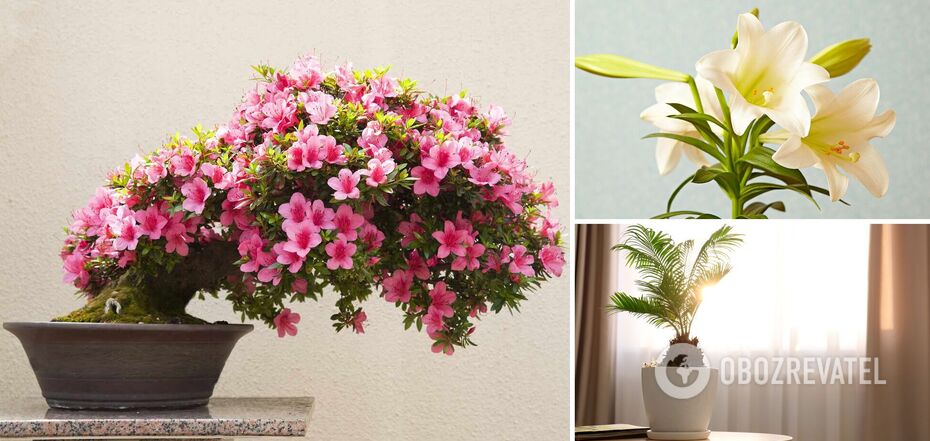Entertainment
Real "vampires": which indoor flowers can make you feel worse
Live greenery in a room creates a special cosiness and can decorate even the simplest interior. But indoor plants can cause allergies and poisoning. At the very least, such plants should be handled with care - take care of them with gloves and make sure that children and pets do not eat them.
OBOZREVATEL talks about flowerpots that can worsen your health in one way or another.
Bonsai
Yes, this is not a type of plant, but a method of growing, from which a full-fledged large tree can become dwarfed, as if it were a toy, and look incredibly impressive in the interior. But the problem is that the ability of such a plant to cause allergies during flowering does not decrease in the same way as its size. People prone to allergies should choose bonsai very carefully.
English ivy
This plant has become very popular among home gardening enthusiasts for its unpretentiousness. English ivy thrives in the cold, in the twilight, and even in conditions of poor watering. At the same time, it has a large leaf mass, grows quickly and looks very impressive. But do not forget that it is the closest relative of poison ivy and has similar properties, can cause burns and itching, and can even be fatal for pets. This plant should only be handled with gloves.
Epipremnum
Another house loosestrife that can be dangerous. The sap of epipremnum contains saponins, which are substances that irritate the mucous membranes, including the stomach and intestines, and cause nausea, vomiting, diarrhoea, and dizziness. Therefore, keep the plant away from children and animals and remember to wear gloves.
Philodendron
This more spectacular relative of the epipremnum has similar properties when it comes to sap getting on the skin and mucous membranes. Therefore, the rules for caring for it are similar.
Euphorbia
Euphorbia, aka poinsettia, aka Christmas star, like most plants of the Euphorbiaceae family, has a toxic effect if its juice gets on the skin or mucous membranes. It should be especially carefully protected from animals - it is very dangerous for them. The same applies to triangular milkweed, ribbed milkweed, Mil's milkweed, jellyfish head and other species of this family to varying degrees.
Oleander
During the flowering period, this plant looks simply incredible thanks to its delicate pink flowers. However, they can be very harmful to people who are allergic to pollen. In addition, all parts of the oleander contain glycosides that can cause severe poisoning. Therefore, if you decide to have an oleander, get a pair of gloves for handling it and be very careful when disposing of any parts of the plant - they are dangerous even when dried. Burning oleander twigs and dry leaves is strictly forbidden. Neither should you make skewers out of it.
Caladium
If a person comes into contact with the sap of this plant, they may suffer burns of the mucous membranes of the mouth and throat, skin irritation, vomiting and diarrhoea. For pets, this plant can be deadly.
Dieffenbachia
The juice of this plant can cause severe allergies, and in the most sensitive people, even lead to respiratory failure and heart problems. In addition, Dieffenbachia is very dangerous for pets. Therefore, pots with this beautiful plant should be kept out of their reach. But sensitive growers are advised to look for a safer alternative.
Long-flowered lily
Of all the lilies that are dangerous to cats, this is the most dangerous. It can cause severe kidney damage in felines and rapid death of the animal within just 18 hours. Therefore, if your cat has started to show interest in this flower, you will most likely have to choose one of them. And don't forget that almost any flowering plant releases a strong allergen in the form of pollen.
Sag palm
A miniature palm tree can turn your home into a real tropical paradise. But the sagovnik has one dark secret. This is a very ancient species that has survived to this day because no animals have even tried to eat it - all parts of the plant are so poisonous. Eating the leaves, seeds or parts of the trunk can lead to a severe negative reaction up to liver failure.
Zamioculcas
This spectacular succulent is a favourite of lazy gardeners. It thrives even in the dark and in the absence of watering for a long time. But it can harm children and pets if they swallow at least part of the plant. The juice of zamioculcas can cause symptoms similar to food poisoning, it is also an allergen, and eating the plant is fatal for pets.
Earlier, OBOZREVATEL talked about indoor plants that can effectively purify air and housing.
Only verified information is available in our Obozrevatel Telegram channel and Viber. Do not fall for fakes!



























